
Appearance
Its appearance is that of a typical sea turtle. "C. mydas" has a dorsoventrally flattened body, a beaked head at the end of a short neck, and paddle-like arms well-adapted for swimming. Adult green turtles grow to 1.5 metres long. The average weight of mature individuals is 68–190 kg and the average carapace length is 78–112 cm. Exceptional specimens can weigh 315 kg or even more, with the largest known "C. mydas" having weighed 395 kg and measured 153 cm in carapace length.Anatomically, a few characteristics distinguish the green turtle from the other members of its family. Unlike its close relative the hawksbill turtle, the green turtle's snout is very short and its beak is unhooked. The neck cannot be pulled into the shell. The sheath of the turtle's upper jaw possesses a denticulated edge, while its lower jaw has stronger, serrated, more defined denticulation. The dorsal surface of the turtle's head has a single pair of prefrontal scales. Its carapace is composed of five central scutes flanked by four pairs of lateral scutes. Underneath, the green turtle has four pairs of inframarginal scutes covering the area between the turtle's plastron and its shell. Mature "C. mydas" front appendages have only a single claw, although a second claw is sometimes prominent in young specimens.
The carapace of the turtle has various color patterns that change over time. Hatchlings of "Chelonia mydas", like those of other marine turtles, have mostly black carapaces and light-colored plastrons. Carapaces of juveniles turn dark brown to olive, while those of mature adults are either entirely brown, spotted or marbled with variegated rays. Underneath, the turtle's plastron is hued yellow. "C. mydas" limbs are dark-colored and lined with yellow, and are usually marked with a large dark brown spot in the center of each appendage.The green sea turtles exhibit sex differences by their development and appearance. As adult turtles, males are easily distinguishable from the females by having a longer tail and longer claws on the front flippers. The hatching time and sex of the turtles are determined by the incubation temperature of the nest. Hatchings occur more quickly in nests that are warmer than nests that are in cooler conditions. Warm nesting sites above 30 degrees Celsius favor the development of females, whereas nesting sites below 30 degrees Celsius produce males. The position of the egg in the nest also affects sex-determination. Eggs in the center tend to hatch as females due to the warmer conditions within the nest.
Green sea turtles play an essential role in the ecosystem in which they live. In the seagrass beds, the turtles feed on the seagrass by trimming only the top and leaving the roots of the plant. Through their feeding technique, the turtles help to improve the health and growth of the seagrass beds. The healthy seagrass beds that the turtles provide give habitat and feeding grounds for many species of fish and crustaceans. On the nesting beaches, the green sea turtles provide key nutrients for the ecosystem through their hatched egg shells. In their coral reef habitat, the green sea turtles have a symbiotic interaction with reef fish, including the yellow tang. The yellow tang fish swims along with the turtle and feeds on the algae, barnacles, and parasites on its shell and flippers. This species interaction provides food for the yellow tang and provides a necessary cleaning and smoothing of the turtle's shell. This cleaning helps the turtles swim by reducing the amount of drag and improves their health.
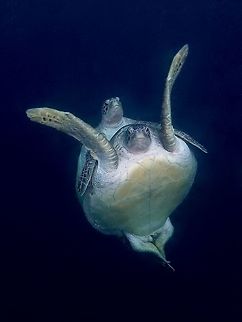
Distribution
The range of the green sea turtle extends throughout tropical and subtropical oceans worldwide. The two major subpopulations are the Atlantic and the eastern Pacific subpopulations. Each population is genetically distinct, with its own set of nesting and feeding grounds within the population's known range. One of the genetic differences between the two subpopulations is the type of mitochondrial DNA found in individual's cells. Individuals from rookeries in the Atlantic Ocean and Mediterranean Sea have a similar type of mitochondrial DNA, and individuals from the Pacific and Indian Oceans have another type of mitochondrial DNA. Their native range includes tropical to subtropical waters along continental coasts and islands between 30°N and 30°S. Since green sea turtles are a migrating species, their global distribution spans into the open ocean. The differences in mitochondrial DNA more than likely stems from the populations being isolated from each other by the southern tips of both South America and Africa with no warm waters for the green sea turtles to migrate through. The green sea turtle is estimated to inhabit coastal areas of more than 140 countries, with nesting sites in over 80 countries worldwide throughout the year. In the United States Atlantic coast, green sea turtles can be found from Texas and north to Massachusetts. In the United States Pacific coast, they have been found from southern California north to the southernmost tip of Alaska. The largest populations of green sea turtles within the United States coastline are in the Hawaiian Islands and Florida. Globally, the largest populations of sea turtles are in the Great Barrier Reef in Australia, and the Caribbean Sea.The green sea turtle can generally be found throughout the Atlantic Ocean. Although the species is most abundant in tropical climates, green sea turtles can also be found in temperate climates, and individuals have been spotted as far north as Canada in the western Atlantic, and the British Isles in the east. The subpopulation's southern range is known until past the southern tip of Africa in the east and Argentina in the western Atlantic. The major nesting sites can be found on various islands in the Caribbean, along the Atlantic coast of Florida in the United States, the eastern coast of the South American continent and most notably, on isolated North Atlantic islands.In the Caribbean, major nesting sites have been identified on Aves Island, the U.S. Virgin Islands, Puerto Rico, the Dominican Republic, and Costa Rica. In recent years, there are signs of increased nesting in the Cayman Islands. One of the region's most important nesting grounds is in Tortuguero in Costa Rica. In fact, the majority of the Caribbean region's "C. mydas" population hails from a few beaches in Tortuguero. Within United States waters, minor nesting sites have been noted in the states of Georgia, North Carolina, and South Carolina. Florida's east coast is the largest nesting site in the United States. Hutchinson Island in particular is a major nesting area in Florida waters. Florida has several annual nesting periods when local beaches are closed or cordoned off to protect nesting sites. According to Green Sea Turtle Watch, in 2015 more than 37,000 green sea turtle nests were documented in Florida, a record number. In addition to sporadic distribution of nesting sites, feeding grounds are much more widely distributed throughout Florida. Important feeding grounds in Florida include Indian River Lagoon, the Florida Keys, Florida Bay, Homosassa, Crystal River, and Cedar Key.
Notable locations in South America include secluded beaches in Suriname and French Guiana. In the Southern Atlantic Ocean, the most notable nesting grounds for "Chelonia mydas" are found on the island of Ascension, hosts 6,000–13,000 turtle nests.In the Pacific, its range reaches as far north as the southern coast of Alaska and as far south as Chile in the east. The turtle's distribution in the western Pacific reaches north to Japan and southern parts of Russia's Pacific coast, and as far south as the northern tip of New Zealand and a few islands south of Tasmania. Significant nesting grounds are scattered throughout the entire Pacific region, including Mexico, the Hawaiian Islands, the South Pacific, the northern coast of Australia, and Southeast Asia. Major Indian Ocean nesting colonies include India, Pakistan, Sri Lanka and other coastal countries.
The turtles can also be found throughout the Indian Ocean; the east coast of the African continent hosts a few nesting grounds, including islands in the waters around Madagascar.

Status
In recent decades, sea turtles have moved from unrestricted exploitation to global protection, with individual countries providing additional protection, although serious threats remain unabated.All populations are considered "threatened".
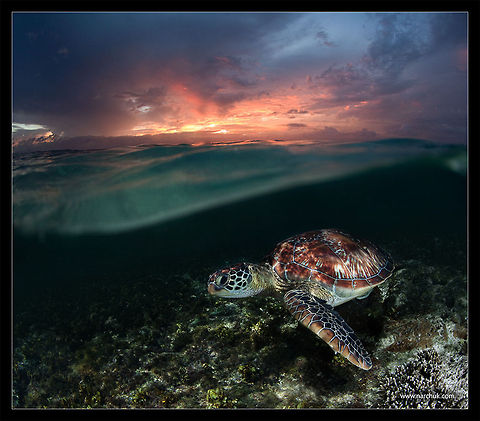
Behavior
As one of the first sea turtle species studied, much of what is known of sea turtle ecology comes from studies of green turtles. The ecology of "C. mydas" changes drastically with each stage of its life history. Newly emerged hatchlings are carnivorous, pelagic organisms, part of the open ocean mininekton. In contrast, immature juveniles and adults are commonly found in seagrass meadows closer inshore as herbivorous grazers.Green sea turtles migrate long distances between feeding sites and nesting sites; some swim more than 2,600 kilometres to reach their spawning grounds. Beaches in Southeast Asia, India, islands in the western Pacific, and Central America are where green sea turtles breed. Mature turtles often return to the exact beach from which they hatched. Females usually mate every two to four years. Males, on the other hand, visit the breeding areas every year, attempting to mate. Mating seasons vary between populations. For most "C. mydas" in the Caribbean, mating season is from June to September. The French Guiana nesting subpopulation nests from March to June. In the tropics, green turtles nest throughout the year, although some subpopulations prefer particular times of the year. In Pakistan, Indian Ocean turtles nest year-round, but prefer the months of July to December.Sea turtles return to the beaches on which they were born to lay their own eggs. The reason for returning to native beaches may be that it guarantees the turtles an environment that has the necessary components for their nesting to be successful. These include a sandy beach, easy access for the hatchlings to get to the ocean, the right incubation temperatures, and low probability of predators that may feed on their eggs. Over time these turtles have evolved these tendencies to return to an area that has provided reproductive success for many generations. Their ability to return to their birthplace is known as natal homing. The males also return to their birthplaces in order to mate. These males that return to their homes know they will be able to find mates because the females born there also return to breed. By doing this, the green sea turtles are able to improve their reproductive success and is why they are willing to expend the energy to travel thousands of miles across the ocean in order to reproduce.
Mating behaviour is similar to other marine turtles. Female turtles control the process. A few populations practice polyandry, although this does not seem to benefit hatchlings. After mating in the water, the female moves above the beach's high tide line, where she digs a hole 11-22 inches in depth with her hind flippers and deposits her eggs. The hole is then covered up again. Clutch size ranges between 85 and 200, depending on the age of the female. This process takes about an hour to an hour and a half. After the nest is completely covered, she returns to the sea. The female will do this 3 to 5 times in one season.
The eggs are round and white, and about 45 mm in diameter. The hatchlings remain buried for days until they all emerge together at night. The temperature of the nest determines the sex of the turtles at around the 20-40 day mark. At around 50 to 70 days, the eggs hatch during the night, and the hatchlings instinctively head directly into the water. This is the most dangerous time in a turtle's life. As they walk, predators, such as gulls and crabs, feed on them. A significant percentage never make it to the ocean. Little is known of the initial life history of newly hatched sea turtles. Juveniles spend three to five years in the open ocean before they settle as still-immature juveniles into their permanent shallow-water lifestyle. It is speculated that they take twenty to fifty years to reach sexual maturity. Individuals live up to eighty years in the wild. It is estimated that only 1% of hatchlings reach sexual maturity.
Each year on Ascension Island in the South Atlantic, "C. mydas" females create 6,000 to 25,000 nests. They are among the largest green turtles in the world; many are more than a metre in length and weigh up to 300 kilograms.
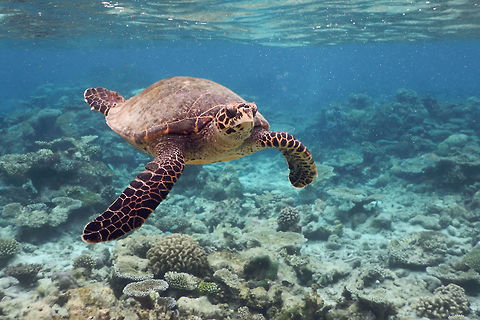
Habitat
Green sea turtles move across three habitat types, depending on their life stage. They lay eggs on beaches. Mature turtles spend most of their time in shallow, coastal waters with lush seagrass beds. Adults frequent inshore bays, lagoons, and shoals with lush seagrass meadows. Entire generations often migrate between one pair of feeding and nesting areas. Green sea turtles, "Chelonia mydas", are classified as an aquatic species and are distributed around the globe in warm tropical to subtropical waters. The environmental parameter that limits the distribution of the turtles is ocean temperatures below 7 to 10 degrees Celsius. Within their geographical range, the green sea turtles generally stay near continental and island coastlines. Near the coastlines, the green sea turtles live within shallow bays and protected shores. In these protected shores and bays, the green sea turtle habitats include coral reefs, salt marshes, and nearshore seagrass beds. The coral reefs provide red, brown, and green algae for their diet and give protection from predators and rough storms within the ocean. The salt marshes and seagrass beds contain seaweed and grass vegetation, allowing ample habitat for the sea turtles.Turtles spend most of their first five years in convergence zones within the bare open ocean that surround them. These young turtles are rarely seen as they swim in deep, pelagic waters. Green sea turtles typically swim at 2.5–3 km/h.As one of the first sea turtle species studied, much of what is known of sea turtle ecology comes from studies of green turtles. The ecology of "C. mydas" changes drastically with each stage of its life history. Newly emerged hatchlings are carnivorous, pelagic organisms, part of the open ocean mininekton. In contrast, immature juveniles and adults are commonly found in seagrass meadows closer inshore as herbivorous grazers.
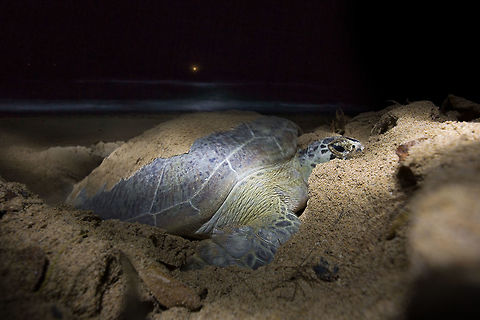
Food
The diet of green turtles changes with age. Juveniles are carnivorous, but as they mature they become omnivorous. Young sea turtles eat fish eggs, sea hare eggs, hydrozoans, bryozoans, molluscs, jellyfish, small invertebrates, worms, sponges, algae, and crustaceans. Green sea turtles have a relatively slow growth rate because of the low nutritional value of their diet. Body fat turns green because of the consumed vegetation. This diet shift has an effect on the green turtle's skull morphology. Their serrated jaw helps them chew green and red algae, red moss, freshwater red algae, lobster horns, sea lettuce, green seaweed, and crinkle grass ) and sea grasses. They also consume large quantities of wetland plants such as "Avicennia schaueriana" and "Sporobolus alterniflorus", which are commonly found in salt marshes. Most adult sea turtles are strictly herbivorous.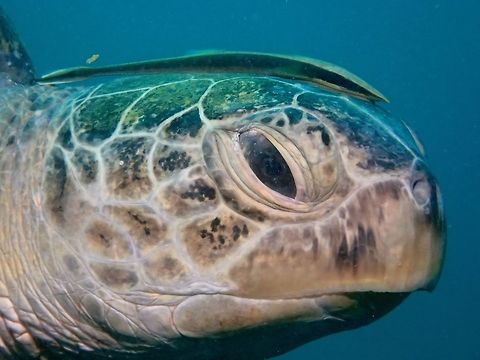
Predators
Only human beings and the larger sharks feed on "C. mydas" adults. Specifically, tiger sharks hunt adults in Hawaiian waters....hieroglyph snipped... Juveniles and new hatchlings have significantly more predators, including crabs, small marine mammals and shorebirds. Additionally, their eggs are vulnerable to predation by scavengers like red foxes and golden jackals.Green sea turtles have a variety of parasites including barnacles, leeches, protozoans, cestodes, and nematodes. Barnacles attach to the carapace, and leeches to the flippers and skin of the turtles, causing damage to the soft tissues and leading to blood loss. Protozoans, cestodes and nematodes lead to many turtle deaths because of the infections in the liver and intestinal tract they cause. The greatest disease threat to the turtle population is fibropapilloma, which produces lethal tumor growth on scales, lungs, stomach, and kidneys. Fibropapilloma is caused by a herpesvirus that is transmitted by leeches such as "Ozobranchus branchiatus", a species of leech which feeds almost entirely on green sea turtles.Human action presents both intentional and unintentional threats to the species' survival. Intentional threats include continued hunting, poaching and egg harvesting. More dangerous are unintentional threats, including boat strikes, fishermen's nets that lack turtle excluder devices, pollution and habitat destruction. Chemical pollution may create tumors; effluent from harbors near nesting sites may create disturbances; and light pollution may disorient hatchlings. With chemical pollution present, there is a development of tar balls that is often eaten by green sea turtles in a confusion of their food. Tar balls cause the green sea turtle to intake toxins that can block their guts, displace the liver and intestines causing swelling of the tissue. Habitat loss usually occurs due to human development of nesting areas. Beach-front construction, land "reclamation" and increased tourism are examples of such development. An infectious tumor-causing disease, fibropapillomatosis, is also a problem in some populations. The disease kills a sizeable fraction of those it infects, though some individuals seem to resist the disease. In addition, at least in the Southwestern Atlantic, exotic invasive species such as the rapa whelk Rapana venosa, were reported massively bio-fouling immature green turtles, reducing buoyancy, increasing drag, and causing severe injuries to the carapace. Because of these threats, many populations are in a vulnerable state.
Pacific green turtles' foraging habitats are poorly understood and mostly unknown. These foraging grounds are most likely along the coast of Baja California, Mexico and southern California, in which these turtles have a high risk of incidental capture by coastal fisheries. The main mortality factor for these turtles is the shrimp trawlers in Mexico, in which many of these turtles go undocumented. The only foraging area that has been identified is the San Diego Bay, but it is heavily polluted with metals and PCBs. These contaminants have a negative effect on the ocean environment, and have been shown to cause lesions and sometimes mortality. Green turtles also are threatened by entanglement and ingestion of plastic. In San Diego Bay, an adult green turtle was found dead with monofilament netting tightly packed in its esophagus. In addition there are indications that global climate change is affecting the ability of green turtle populations in Australia to produce males due to their temperature-dependent sex determination and the rising temperatures in the northern Great Barrier Reef region. Construction of new thermal power stations can raise local water temperature, which is also said to be a threat.
Green sea turtles are the most commonly traded species along Java's south coast and are sold in the form of whole, stuffed animals or turtle oil, locally known as "minyak bulus".
The geographer James J. Parsons' book titled "The Green Turtle and Man" played a special role in the conservation movement to save the species from extinction.
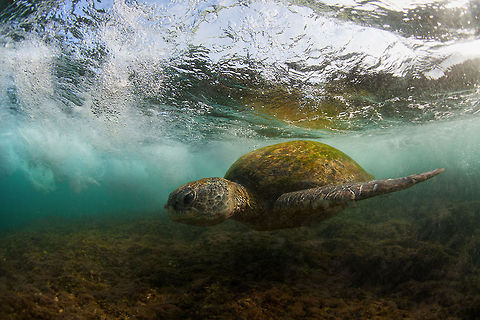
Defense
Nesting grounds are found all along the Mexican coast. These turtles feed in seagrass pastures in the Gulf of California. Green turtles belonging to the distinct Hawaiian subpopulation nest at the protected French Frigate Shoals some 800 kilometers west of the Hawaiian Islands.In the Philippines, green turtles nest in the Turtle Islands along with closely related hawksbill turtles.
In December 2007, fishermen using a "hulbot-hulbot" accidentally caught an 80 kg, 93 cm long and 82 cm wide turtle off Barangay Bolong, Zamboanga City, Philippines. December is breeding season near the Bolong beach.
Indonesia has a few nesting beaches, one in the Meru Betiri National Reserve in East Java.
Off the north-eastern and northern coasts of Australia, the Great Barrier Reef has two genetically distinct populations; one north and one south. Within the reef, 20 separate locations consisting of small islands and cays were identified as nesting sites for either population of "C. mydas". Of these, the most important is on Raine Island. In the Torres Strait there is a large rookery on Bramble Cay. The Coral Sea has nesting areas of world significance.
Major nesting sites are common on either side of the Arabian Sea, both in Ash Sharqiyah, Oman, and along the coast of Karachi, Pakistan. Some specific beaches there, such as Hawke's Bay and Sandspit, are common to both "C. mydas" and "L. olivacea" subpopulation. Sandy beaches along Sindh and Balochistan are nesting sites. Some 25 kilometers off the Pakistani coast, Astola island is another nesting beach.
References:
Some text fragments are auto parsed from Wikipedia.